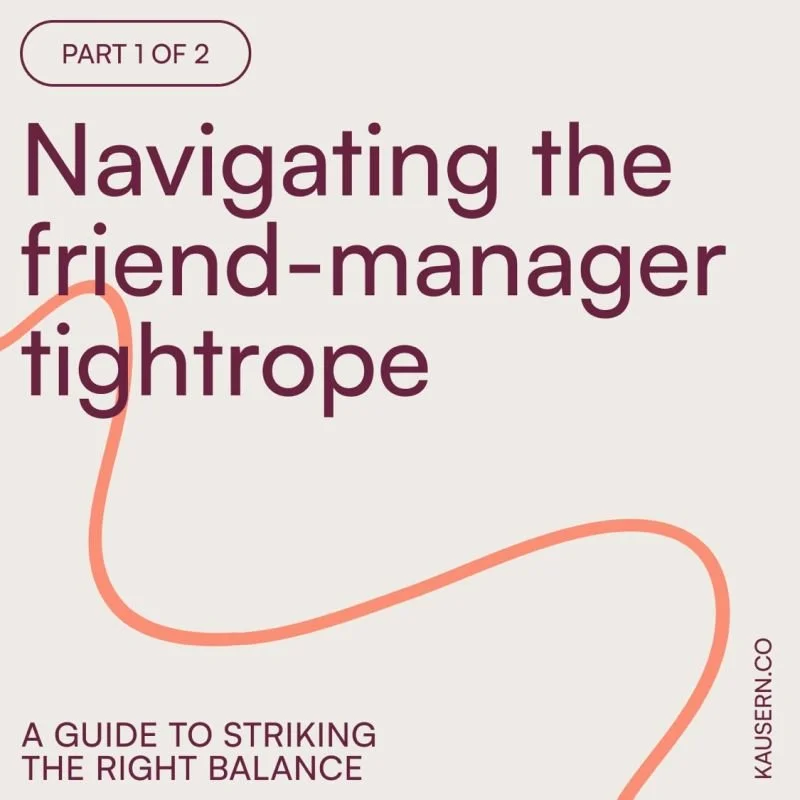Part 1: Navigating the friend-manager tightrope
🔴 When I did a recent live demo of the Leadership Pod (a peer leadership group programme I’ll be conducting in Jan 2024, more details below!) this leadership subject was a hot topic. The participants wanted to find out how to delicately balance their professional authority with their personal connection to their team members.
Young leaders dream of building a team where camaraderie and team performance thrives. I myself have been there before, and I stepped on many toes trying to strike the right balance.
Here are some of my learnings: a step-by-step guide in walking the friend-manager tightrope. (Next week I’ll be sharing what to do if that friendship line is inadvertently crossed)
𝐒𝐭𝐞𝐩 𝟏: 𝐒𝐞𝐭 𝐜𝐥𝐞𝐚𝐫 𝐞𝐱𝐩𝐞𝐜𝐭𝐚𝐭𝐢𝐨𝐧𝐬 𝐟𝐫𝐨𝐦 𝐭𝐡𝐞 𝐬𝐭𝐚𝐫𝐭
Make it known from the beginning that while you value friendship, there are professional boundaries that must be respected. Communicate the expectations for work-related matters and overall performance to ensure everyone is on the same page.
𝐒𝐭𝐞𝐩 𝟐: 𝐌𝐚𝐢𝐧𝐭𝐚𝐢𝐧 𝐩𝐫𝐨𝐟𝐞𝐬𝐬𝐢𝐨𝐧𝐚𝐥𝐢𝐬𝐦
During work hours, separate professional interactions from personal ones. Focus on tasks and deadlines, and keep personal discussions to a minimum.
𝐒𝐭𝐞𝐩 𝟑: 𝐅𝐨𝐬𝐭𝐞𝐫 𝐛𝐨𝐧𝐝𝐢𝐧𝐠 𝐚𝐜𝐭𝐢𝐯𝐢𝐭𝐢𝐞𝐬
Encourage team bonding activities that are inclusive and promote a sense of unity after work hours, e.g. lunch outings, or casual Friday activities. I like to go the extra mile to get to know my team a little bit more on a personal level e.g. share cat videos to teammates who adore cats, ask how a parent is doing if they’re unwell, and sometimes surprise them with small individualised gifts.
𝐒𝐭𝐞𝐩 𝟒: 𝐁𝐞 𝐜𝐨𝐧𝐬𝐢𝐬𝐭𝐞𝐧𝐭 𝐢𝐧 𝐲𝐨𝐮𝐫 𝐭𝐫𝐞𝐚𝐭𝐦𝐞𝐧𝐭
Consistency is key. Treat all team members fairly and equally to avoid perceptions of favouritism. If one employee perceives that your friendship with another is affecting work-related decisions, it can lead to resentment and a breakdown of team dynamics.
𝐒𝐭𝐞𝐩 𝟓: 𝐊𝐧𝐨𝐰 𝐖𝐡𝐞𝐧 𝐭𝐨 𝐃𝐫𝐚𝐰 𝐭𝐡𝐞 𝐋𝐢𝐧𝐞
Recognizing the appropriate times to shift from friend to manager is crucial. When discussing work-related issues or providing feedback, switch to a more formal tone to reinforce your managerial role. It's important for your team to understand that while you may be friends, work-related discussions require a different level of professionalism.
Finding the right balance between being a friend and a manager is an ongoing process. Regularly reflect on the dynamics within your team and redefine the boundaries if needed. Your ultimate role as a leader is to prioritise the professional growth and success of your team while maintaining a friendly atmosphere.

